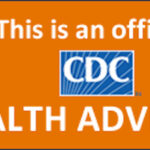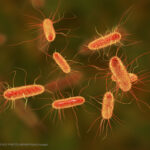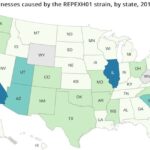Learn how to protect yourself in the wake of cuts to FDA, USDA, and CDC. Today we learned that many scientists and food safety experts have lost their jobs at those agencies. What does that mean to you and your family and how can you protect yourself? You have always been the final piece of the puzzle for food safety. Contaminated food has always been sold; in fact, the government has allowed chicken to be sold when it is contaminated with a certain level of Salmonella, and recalls often come after people have been sickened by contaminated food. So if you are already following food safety precautions you are ahead of the game. First of all, always follow the rule of Clean, Separate, Cook, and Chill. Wash your hands before you start cooking. Start with a clean kitchen and … [Read more...]
One-Third of Food Outbreaks Linked to Non-Irradiated Food
One-third of food outbreaks are linked to non-irradiated foods, according to a report in the Centers for Disease Control and Prevention's Emerging Infectious Diseases report for June 2024. Those foods are eligible for irradiation treatment, which kills pathogens and extends the life of produce and other foods. Of 482 outbreaks, 155 were linked to an irradiation-eligible food; none of those foods were irradiated. Irradiation is controversial, with some significant consumer resistance and large fixed costs. The FDA has approved certain foods for this type of treatment, including poultry, fresh shell eggs, spices, and meat. The FDA says that food irradiation is safe, and can control pathogens and insects. It can reduce the use of pesticides on foods, and can preserve food for … [Read more...]
Health Advisory Issued For Highly Pathogenic Avian Influenza
A health advisory has been issued by the Centers for Disease Control and Prevention (CDC) for highly pathogenic avian influenza A (H5N1) virus, otherwise known as bird flu. One person has been infected. The person got sick after exposure to allegedly infected dairy cattle. The virus has been found in U.S. dairy cattle in multiple states. The farm worker was an employee at a commercial dairy farm in Texas. The patient reported conjunctivitis with no other symptoms, was not hospitalized and is recovering. The patient isolated and received antiviral treatment, while family members received oseltamivir for post-exposure prophylaxis according to CDC recommendations. The patient specimen was compared to the viral sequences from cattle, and lacks changes that would make it better … [Read more...]
Undercooked Morels Associated With Deadly Outbreak in MT
The Centers for Disease Control and Prevention (CDC) is reporting that uncooked and undercooked morels were associated with a deadly outbreak at Dave's Sushi in Bozeman Montana in March and April 2023 that killed two people. Fifty-one people were sickened after eating at that restaurant. Three people were hospitalized. The issue is that while morel mushrooms are considered edible, little is known about the human health effects of the fungi. In the study, the consumption of raw morels was more strongly associated with illness than the consumption of cooked or partially cooked morels. After the outbreak the CDC issued an advisory about eating morel mushrooms, whether cooked or not, saying that wild mushrooms should be consumed at your own risk. Morels were the common food consumed … [Read more...]
Huntley High School E. coli Illnesses Linked to Multistate Outbreak
The CDC has confirmed that the Huntley High E. coli illnesses last month are linked to a multistate outbreak. Katia Martinez, Health Communication Specialist for the Division of Foodborne, Waterborne, and Environmental Diseases (DFWED) and National Center for Emerging and Zoonotic Infectious Disease (NCEZID) of the Centers for Disease Control and Prevention told Food Poisoning Bulletin that as of October 25, 2023, there are 22 people in 10 states that are sick with E. coli infections and that the Huntley outbreak is linked to those illnesses. Three people in this outbreak have developed hemolytic uremic syndrome (HUS), which is a type of kidney failure. Officials have not identified the source of the outbreak, and the CDC is working with state health partners to interview patients. … [Read more...]
CDC Issues HAN Report About Severe Vibrio Vulnificus Infections
The CDC has issued a HAN Report about severe Vibrio vulnificus infections that are associated with warming coastal waters. The report is to notify healthcare providers, laboratories, and public health departments about recent reports of fatal Vibrio vulnificus infections from food and infected wounds, and to warn the public about this issue. Vibrio causes about 80,000 human illnesses every year in the United States. About a dozen species of this pathogen are pathogenic to humans. Vibrio parahaemolyticus causes the most infections, follow by Vibrio alginolyticus. About 150 to 200 Vibrio vulnificus infections are reported to the CDC every year. About 20% of these infections are fatal. Vibrio species live in coastal waters, including salt water and brackish water, which is a mixture … [Read more...]
Foodborne Illness is Back to Pre-Pandemic Levels
Foodborne illness is back to pre-pandemic levels for some pathogens, according to research published in the Center for Disease Control and Prevention's Morbidity and Mortality Weekly Report (MMWR) for the week of June 30, 2023. The incidences that were higher were infections caused by Shiga toxin-producing E. coli, Yersinia, Vibrio, and cyclopsora. Campylobacter, Salmonella, Shigella, and Listeria illness levels did not change. In other words, progress in reducing enteric infection levels was not observed in 2022. The report states that collaboration among food growers, processors, retail stores, restaurants, and regulators is needed to reduce pathogen contamination during poultry slaughter and to prevent contamination of leafy greens. During the pandemic, foodborne … [Read more...]
Sick Restaurant Employees Cause 40% of Outbreaks
Sick restaurant employees cause 40% of foodborne illness outbreaks, according to an article in the Center for Disease Control and Prevention's (CDC) Morbidity and Mortality Weekly Report for the week of June 2, 2023. Hundreds of foodborne illness outbreaks associated with retail food establishments are reported every year to the CDC. The period of time included in this study was 2017 to 2019. In 2014, CDC launched the National Environmental Assessment Reporting System (NEARS) to compliment the surveillance conducted by the National Outbreak Reporting System (NORS). State and local health departments enter data from their outbreak investigations of retail food establishments. The data entered include characteristics of outbreaks, including factors contributing to the illnesses, … [Read more...]
Persistent Strain of E. coli O157:H7 in United States, Says CDC
The CDC says that there is a persistent strain of E. coli O157:H7 in the United States that has caused illnesses and outbreaks. Illnesses caused by this strain, REPEXH01, occur year round but are less common in the winter. This strain has sickened people through contaminated food and contaminated recreational water. Persistent is a term used by the CDC to describe strains that have caused illnesses for years. Even though the number of illnesses may change over time, they continue to cause sickness. And these strains are sometimes linked to more than one course, making them more difficult to control. The strain is "relatively" diverse genetically, within 21 allele differences of one another. That is more diverse than pathogens that cause typical multistep foodborne illnesses … [Read more...]
The CDC is Warning About Bird Flu Detections in Backyard Birds
If you buy chicken at the grocery store, you may have noticed that some products are becoming more scarce. Supply chain issues aside, that may be because the bird flu numbers in poultry are approaching record numbers. The Centers for Disease Control and Prevention (CDC) says that the highly pathogenic avian influenza (HPAI) A(H5) virus has now sickened 52,773,869 birds in the United States. The birds that are affected include wild aquatic birds, commercial poultry, and backyard or hobbyist flocks beginning in January 2022. Thees are the first detections of this particular strain in this country since 2016. The illness has been found in 46 states in this country and in 341 countries around the world. In November 2022, the CDC said that 49,000,000 birds in 46 states had either died … [Read more...]














